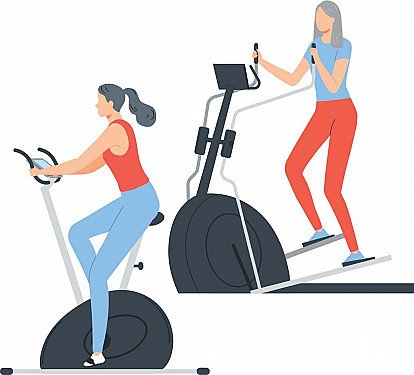Easing into exercise
Even short stints of structured exercise may improve your heart health — and it's never too late to start.

Are you one of those people whose typical day includes doing chores around the house and yard, running errands, and caring for a spouse, grandkids, or pets? Having a busy, active life is one reason people think they don't need to set aside time devoted solely to exercise, says Gisele Bousquet, program director at Harvard-affiliated Brigham and Women's Cardiac Rehabilitation Program in Foxborough, Mass.
"People say, I'm very active, I'm always on the go," she says. Being physically active is good, she tells them. But doing regular moderate exercise — ideally for at least 30 minutes most days of the week — can lower your blood pressure and many other risk factors linked to heart disease. Even if you've never done formal exercise, starting in the second half of life can still make a difference (see "Exercise: Even starting after 60 can help").
Exercise: Even starting after 60 can helpPeople tend to exercise less as they grow older. But bucking that trend may lower your risk of heart disease and stroke, according to a study published last November in the European Journal of Cardiology. Researchers analyzed data from more than 1.1 million South Koreans ages 60 and older without known heart disease. They all had two health screenings between 2009 and 2012 and were followed until the end of 2016. About two-thirds of the participants were physically inactive at both screenings. But those who started exercising one to two times per week by the second screening were 5% less likely to have events such as a heart attack or stroke during the follow-up period compared with adults who remained sedentary. And when people started exercising three to four times per week, their risk of heart-related problems dropped by 11%. |
Find a good fit
Find an activity you enjoy that gets your heart rate up, whether it's walking, swimming, doing water aerobics, or dancing. Using exercise equipment such as an elliptical machine or stationary bike can be a good option, especially when the weather's bad. People with physical limitations (such as low back pain or joint pain) may need to try different options to find a form of exercise that doesn't hurt.
And don't push yourself too hard. That old adage of "no pain, no gain" is simply not true, says Bousquet, a cardiovascular nurse. You don't need to sweat; you just need to get your heart rate up higher than normal. See "The effort of exercise" to get a sense of how hard you should be working, which differs depending on your fitness level.
The effort of exercise |
|
|
When you're just getting started, aim for a light to moderate level of intensity, whether you're walking, cycling, or swimming. Once you get used to exercising on a regular basis, you can gradually increase your level of effort. |
|
|
Intensity |
How it feels |
|
Light |
Light effort, breathing easily; you can sing |
|
Light to moderate |
Some effort, breathing more noticeable; you can talk in full sentences |
|
Moderate |
Moderate effort, breathing harder; you can talk in full sentences but need to take more breaths |
|
Moderate to vigorous |
Hard effort, slightly breathless; you can talk in phrases |
Start low and slow
For people who aren't very active, a full half-hour of exercise can sound daunting, says Bousquet's colleague Lauren Mellett, a physical therapist and cardiopulmonary specialist. "If you're brand-new to exercise, start by exercising for just five to 10 minutes. Try to increase that by two to three minutes, every few sessions," she suggests. You can also split your exercise into two 15-minute sessions, or do three 10-minute bouts of exercise throughout the day. "You won't build as much endurance, but you'll still lower your risk of heart disease," says Mellett.
When people come in for cardiac rehabilitation, their blood pressure is measured repeatedly. If the reading is high when they first arrive, it's often lower about 10 minutes after they finish exercising. That immediate, positive feedback can be very helpful, Mellett says. Those with prediabetes or diabetes often see similar benefits with lowered blood sugar levels after exercise, she adds.
Other proven heart-related benefits of exercise include reducing inflammation and discouraging the formation of harmful blood clots. For additional information and tips, see the Harvard Special Health Report Starting to Exercise (/e).
Image: Martinns/Getty Images
Disclaimer:
As a service to our readers, Harvard Health Publishing provides access to our library of archived content. Please note the date of last review or update on all articles.
No content on this site, regardless of date, should ever be used as a substitute for direct medical advice from your doctor or other qualified clinician.















